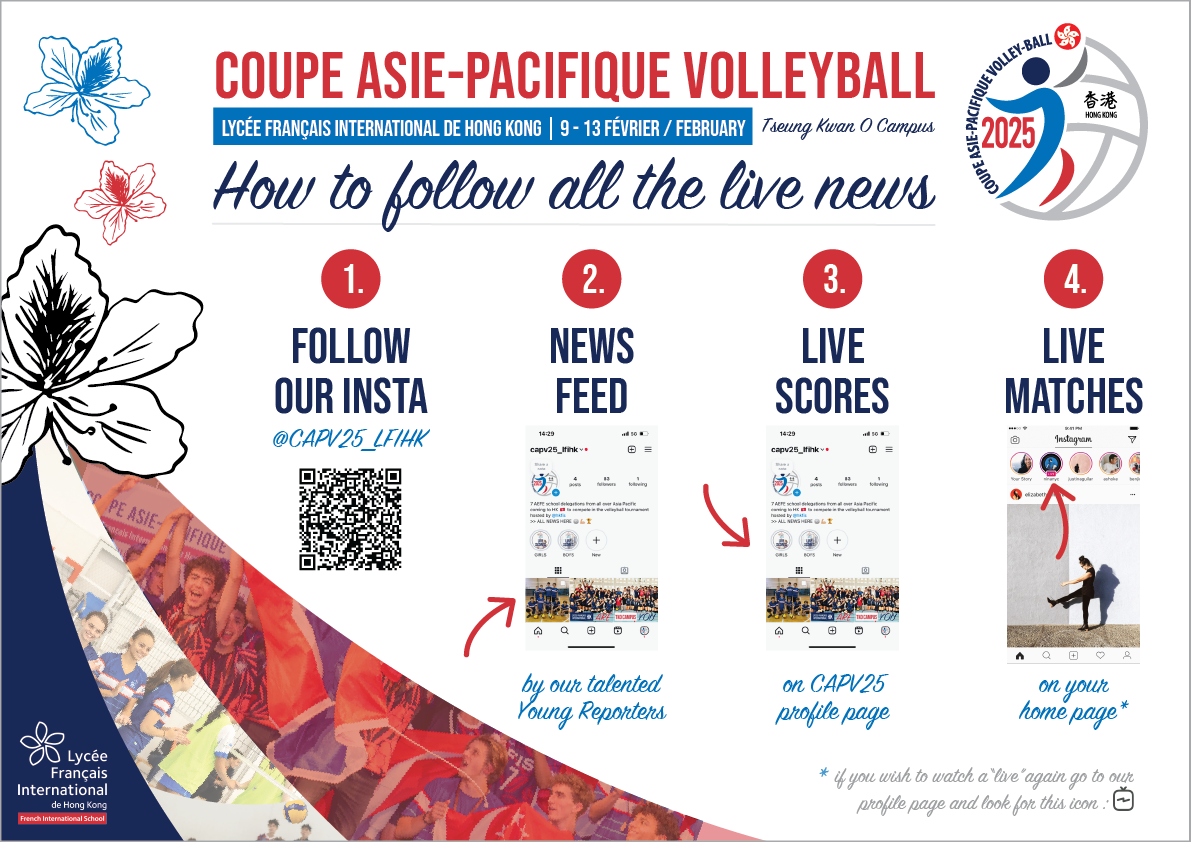Photo et Text Competition : Territoires d’Asie “Des Images et des Mots”

This inter-school educational initiative is open to members of the AEFE network in the Asia-Pacific and Oceania Zone.
The principle is as follows: to wander through one's country, observe the surroundings in order to isolate a "detail" and take a photo related to one of the 17 SDGs, revealing the stark contrasts of the place, all accompanied by an explanatory text.
The themes of the 2024 edition were: "My country and its contrasts!" and "Recycling and waste" for ESD (Education for Sustainable Development).
Our students form 4e and 3e, as well as students from the visual arts option in Seconde, all participated by submitting socially and environmentally conscious photos. Their message is strong and straightforward, and their uncompromising gaze highlights the specific details that make Hong Kong unique. The text accompanying their photo enhances their artistic approach.
It's Lilou FUMOUX, a student in Seconde A at FIS, who won the contest! Here is her photo and text, along with a selection of other submissions that are worth seeing and reading!
Hats off to the artists! We can't wait to discover the theme and photos of the next edition!
Lilou FUMOUX (2A) - Winner of the competition

The photograph captures the rebellion of Mother Nature against urbanisation in Hong Kong (Happy Valley, near the racecourse). She demands back the space that humans have taken from her with surprising determination, destroying forcefully and ferociously everything in her path. This engaged shot portrays nature fighting against urbanisation and alludes to the 9th and 15th Sustainable Development Goals (SDGs). The photograph was taken in a way that highlights the roots pushing apart the pavement on its path. The blurring effect and the capture of light also play a role in emphasising the presented subject.
"When we observe nature, we discover the jokes of a superior irony." - Honoré de Balzac / Massimilla Doni
Jeanne KONÉ (2A)
"Like a Poppy in Hong Kong"
Like a poppy in Hong Kong, vibrant and unique,
A woman emerges, capturing all gazes, unparalleled.
Like a poppy in Hong Kong also refers to a quote that accompanied me throughout my reflection.
Let's play the game, find the differences, the contrasts.
Is it her big smile, filled with joy?
Is it her braids in the air, showing her freedom?
Her vibrant yellow t-shirt?
Or rather her ebony skin color?
Despite all that is believed,
Hong Kong may be a cosmopolitan city,
The difference is noticeable.
Through this photograph I find myself, I reflect, that's why it's personal to me.
Like a poppy in Hong Kong, she is unique
and that's what gives the strength of the image and the moment,
that's the contrast.

Theo WONG (3A)

In this photo, we can see a handcart of this typical style from Hong Kong. This type of cart, called a "handcart," serves as a tool of work, often used by elderly individuals who collect waste to make ends meet at the end of the month. One can observe the contrast between the cart, symbolizing a dark facet of Hong Kong, and the light in the background representing the nocturnal side of Hong Kong that the world perceives. There exists a contrast between darkness and brightness that reflects the inequalities in Hong Kong, often invisible despite being present by our side. These inequalities pose a particular problem for an elderly population with low income, forced to work in the cold and darkness, while others are comfortably settled at home in their warm apartments.
Oriane HONG (3D)
I was coming back from school by train, on an escalator. And as I ascended, I realized that the two parallel escalators were moving in opposite directions, with very few people on the one going upwards. I pondered on this and thought to myself that society was a bit like that, especially in Hong Kong. Two lines and two worlds moving in parallel lines, never to intersect. Two rows continuing on their paths, observing each other. This is the principle of social mobility. The affluent rising higher and higher, and the less fortunate descending lower and lower, social inequalities that are increasing day by day. At the same time, the two lines are forced to coexist. If there is an escalator going down, there will be one going up. In today's world, inequalities continue to dominate, and the two groups are obliged to coexist.







